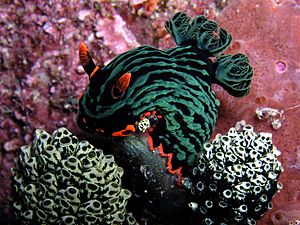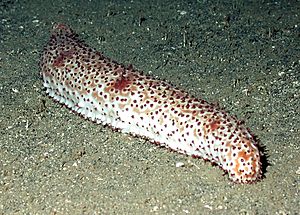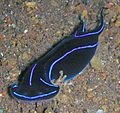Sea slug facts for kids
Quick facts for kids Sea slug |
|
|---|---|
 |
|
| Nembrotha kubaryana feeding on tunicates |
|
| Scientific classification | |
| Kingdom: | |
| Phylum: | |
| Class: | |
| (unranked): |
clade Heterobranchia
|


A sea slug is a cool marine animal that lives in the ocean. It's a common name for many different ocean creatures. Most sea slugs are actually a type of sea snail. These snails have either lost their shells completely over time. Or, their shells have become very small or are hidden inside their bodies.
The name "sea slug" is often used for nudibranchs. It also refers to other ocean snails that don't have obvious shells. These amazing creatures come in many shapes, colors, and sizes. Many of them are partly see-through.
Contents
Amazing Colors and Defenses
Sea slugs that live on coral reefs often have very bright colors. You might think these colors would make them easy targets for predators. But these bright colors are actually a warning! They tell other animals that the sea slug might have stinging cells. Or, they might taste really bad. This helps keep them safe from hungry fish.
What Makes a Sea Slug Special?
Like all gastropods, sea slugs have tiny, sharp teeth. These teeth are called radulas. They use them to scrape or cut their food. Most sea slugs have two pairs of tentacles on their heads. They use these tentacles mostly to smell things in the water. They also have a small eye at the bottom of each tentacle.
Many sea slugs have feathery parts on their backs. These are called cerata. They often have a different color than the rest of the body. These cerata act like gills, helping the sea slug breathe underwater.
What Do Sea Slugs Eat?
Every type of true sea slug has a favorite food. They specialize in eating certain animals. Some sea slugs eat jellyfish. Others munch on tiny animals called bryozoans. Some even eat sea anemones or tiny ocean creatures called plankton. And yes, some sea slugs even eat other kinds of sea slugs!
Images for kids






